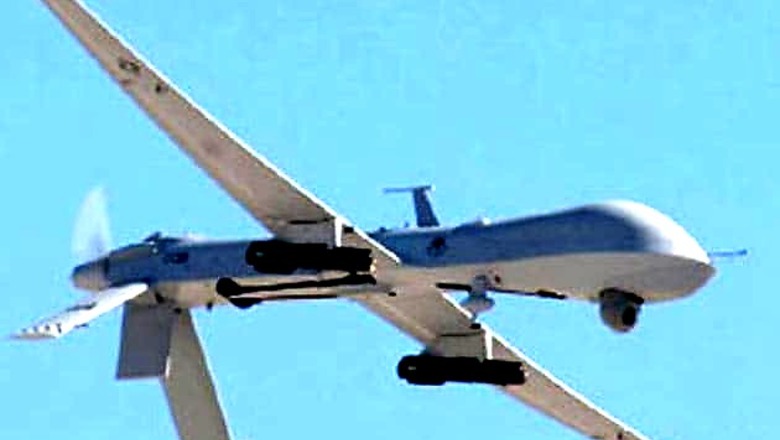
views
Islamabad: The death of a senior al-Qaeda leader in a US drone strike in Pakistan's tribal badlands, the first strike in almost two months, signaled that the US-Pakistan intelligence partnership is still in operation despite political tensions.
The January 10 strike and its follow-up two days later were joint operations, a Pakistani security source based in the tribal areas said.
They made use of Pakistani "spotters" on the ground and demonstrated a level of coordination that both sides have sought to downplay since tensions erupted in January 2011 with the killing of two Pakistanis by a CIA contractor in Lahore.
"Our working relationship is a bit different from our political relationship," the source told Reuters, requesting anonymity. "It's more productive."
US and Pakistani sources told Reuters that the target of the Jan 10 attack was Aslam Awan, a Pakistani national from Abbottabad, the town where Osama bin Laden was killed last May by a U.S. commando team.
They said he was targeted in a strike by a US-operated drone directed at what news reports said was a compound near the town of Miranshah in the border province of North Waziristan.
That strike broke an undeclared eight-week hiatus in attacks by the armed, unmanned drones that patrol the tribal areas and are a key weapon in US President Barack Obama's counter-terrorism strategy.
The sources described Awan, also known by the nom-de-guerre Abdullah Khorasani, as a significant figure in the remaining core leadership of al Qaeda, which US officials say has been sharply reduced by the drone campaign. Most of the drone attacks are conducted as part of a clandestine CIA operation.
The Pakistani source, who helped target Awan, could not confirm that he was killed, but the US official said Awan had spent time in London and had ties to British extremists before returning to Pakistan.
The source, who says he runs a network of spotters primarily in North and South Waziristan, described for the first time how US-Pakistani cooperation on strikes works, with his Pakistani agents keeping close tabs on suspected militants and building a pattern of their movements and associations.
"We run a network of human intelligence sources," he said. "Separately, we monitor their cell and satellite phones.
"Thirdly, we run joint monitoring operations with our US and UK friends," he added, noting that cooperation with British intelligence was also extensive.
Pakistani and US intelligence officers, using their own sources, hash out a joint "priority of targets lists" in regular face-to-face meetings, he said.
"Al Qaeda is our top priority," he said.
He declined to say where the meetings take place.
Once a target is identified and "marked," his network coordinates with drone operators on the U.S. side. He said the United States bases drones outside Kabul, likely at Bagram airfield about 25 miles north of the capital.
From spotting to firing a missile "hardly takes about two to three hours," he said.
It was impossible to verify the source's claims and American experts, who decline to discuss the drone program, say the Pakistanis' cooperation has been less helpful in the past.
US officials have complained that when information on drone strikes was shared with the Pakistanis beforehand, the targets were often tipped off, allowing them to escape.
Drone strikes have been a sore point with the public and Pakistani politicians, who describe them as violations of sovereignty that produce unacceptable civilian casualties.
The last strike before January had been on Nov 16, 10 days before 24 Pakistani soldiers were killed in what NATO says was an inadvertent cross-border attack on a Pakistani border post.
That incident sent US-Pakistan relations into the deepest crisis since Islamabad joined the US-led war on militancy following the September 11, 2001 attacks. On Thursday, Pakistani foreign minister Hina Rabbani Khar said ties were "on hold" while Pakistan completes a review of the alliance.
The United States sees Pakistan as critical to its efforts to wind down the war in Afghanistan, where US-led NATO forces are battling a Taliban insurgency.
Some US and Pakistani officials say that both sides are trying to improve ties. As part of this process, a US official said, it is possible that some permanent changes could be made in the drone program which could slow the pace of attacks.
The security source said very few innocent people had been killed in the strikes. When a militant takes shelter in a house or compound which is then bombed, "the ones who are harboring him, they are equally responsible," he said.
"When they stay at a host house, they (the hosts) obviously have sympathies for these guys."
He denied that Pakistan helped target civilians.
"If ... others say innocents have been targeted, it's not true," he said. "We never target civilians or innocents."
The New America Foundation policy institute says that of 283 reported strikes from 2004 to Nov 16, 2011, between 1,717 and 2,680 people were killed. Between 293 and 471 were thought to be civilians -- approximately 17 percent of those killed.
The Brookings Institution, however, says civilian deaths are high, reporting in 2009 that "for every militant killed, 10 or more civilians also died." Pakistan's interior minister, Rehman Malik, also said in April 2011 that "the majority of victims are innocent civilians."
Still, despite its public stance, Pakistan has quietly supported the drone program since Obama ramped up air strikes when he took office in 2009 and even asked for more flights.
According to a US State Department cable published by anti-secrecy organization WikiLeaks, Pakistan's chief of army staff General Ashfaq Kayani in February 2008 asked Admiral William J Fallon, then-commander of US Central Command, for increased surveillance and round-the-clock drone coverage over North and South Waziristan.
The security source said Pakistan's powerful spy agency, the Directorate of Inter-Services Intelligence, also was supportive of the strikes, albeit privately.


















Comments
0 comment